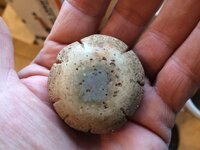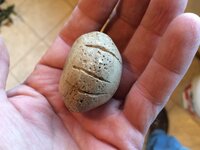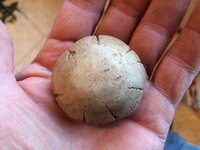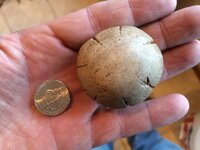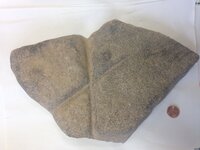Navigation
Install the app
How to install the app on iOS
Follow along with the video below to see how to install our site as a web app on your home screen.
Note: This feature may not be available in some browsers.
More options
You are using an out of date browser. It may not display this or other websites correctly.
You should upgrade or use an alternative browser.
You should upgrade or use an alternative browser.
Unusual or un-identified artifacts
- Thread starter quito
- Start date
Charl
Silver Member
Thanks iowa trout! I and the owner of the site both have cones we found there. They are what I would call traditional cones that are basically half of a sphere.
This is piece is nothing like them.
I had one well versed guy at collinsville at first look instantly say to me "arikara" "Sinew Stone" said he had seen something just like it in the past. I don't know that they were this far east, but they weren't to far north and west. So I don't necessarily think it's from the Arikara people, I do think he may be right about sinew stone though.
Recently, a friend of mine found two beautiful sinew stones. Both quartzite cobbles, with many grooves. Interestingly, both these stones also showed use as hammerstones. I wish I could put his photos up to illustrate that, but won't without his permission. But it initiated a conversation, and several knappers weighed in to state "the grooves were made by abrading the edges of stones during the knapping process." And resulting from "abrading edges in platform perpetration for knapping". Two people experienced in working with sinew felt the stones would be of no help in the processing of sinew.
Well, it is indeed interesting that so many sinew stones do show hammering usage as well. Others have pointed out they would indeed be expected to be a part of knapping kits. Still another reasonable suggestion is a bone tool sharpening groove. They would certainly work for that task as well. Ironically, since the term is so old by now, sinew stones might have nothing at all to do with sinew perpetration.
i can reproduce an illustration here, and if I get permission, I'll post a photo of a sinew stone showing use as a hammer.
The other observation I would like to make is, that regardless of function, every sinew stone I have ever seen has it's appearance as the result of usage. They are cobbles with grooves. They are not crafted from scratch, but assume their appearance as a result of usage, like most abrading stones would. In contrast, the mystery stone here seems to be crafted from scratch.
Amazon Forum Fav 👍
Attachments
Charl
Silver Member
Since it shows a superficial resemblance to a fossil echinoid, I also googled "weathered echinoid fossil" for the heck of it. I doubt that's the answer, but you might find examples down the page where you might see why the thought came to mind in the first place....
https://www.google.com/search?q=wea...KEwji14WbuLbKAhVQ7GMKHTNECVsQ_AUICCgC#imgrc=_
https://www.google.com/search?q=wea...KEwji14WbuLbKAhVQ7GMKHTNECVsQ_AUICCgC#imgrc=_
quito
Silver Member
- Thread starter
- #23
Thanks or the thoughtful reply Charl! I looked online and read a few things about these stones, and saw some examples. Some I didn't agree were properly identified.
Anyway, this piece exhibits a high degree of polish, top and bottom. One end is flat, the other has a crown. The grooves around the sides are not smooth from use as one would expect, so in my humble opinion they were put there for grip. Maybe they were working greasy hides and needed the rough edge.
One of these days I will run down the archy at the local college and see what he has to say.
Anyway, this piece exhibits a high degree of polish, top and bottom. One end is flat, the other has a crown. The grooves around the sides are not smooth from use as one would expect, so in my humble opinion they were put there for grip. Maybe they were working greasy hides and needed the rough edge.
One of these days I will run down the archy at the local college and see what he has to say.
quito
Silver Member
- Thread starter
- #24
Since it shows a superficial resemblance to a fossil echinoid, I also googled "weathered echinoid fossil" for the heck of it. I doubt that's the answer, but you might find examples down the page where you might see why the thought came to mind in the first place....
https://www.google.com/search?q=wea...KEwji14WbuLbKAhVQ7GMKHTNECVsQ_AUICCgC#imgrc=_
I did think utilized fossil at one time, but under microscope, I can not pick any sign of growth lines or rings, or any kind of pattern or feature that stands out in the material, other than high use polish/wear.
Charl
Silver Member
Thanks or the thoughtful reply Charl! I looked online and read a few things about these stones, and saw some examples. Some I didn't agree were properly identified.
Anyway, this piece exhibits a high degree of polish, top and bottom. One end is flat, the other has a crown. The grooves around the sides are not smooth from use as one would expect, so in my humble opinion they were put there for grip. Maybe they were working greasy hides and needed the rough edge.
One of these days I will run down the archy at the local college and see what he has to say.
Thanks, quito. Used as grips as you describe seems logical. And here's one of those sinew stones I referred to, found in RI recently. Shows use as a hammer on one side...
Attachments
quito
Silver Member
- Thread starter
- #27
Thanks, quito. Used as grips as you describe seems logical. And here's one of those sinew stones I referred to, found in RI recently. Shows use as a hammer on one side...
The hammer feature with the sinew stone seems like an odd combination, but them natives were pretty resourceful.
reuellis
Sr. Member
southfork
Bronze Member
rock
Gold Member
Okay I will bring this one back up cause I didnt want to jack somebodies thread. I value your thoughts on this piece. I took it to a show last year and was told it was a broken Guilford Ax. There is a inclusion of quartz on the unfinished side. Could be broken not sure. It has hafting section in the middle like a ax on top and bottom. But it fits nicely in hand to like a hand ax. I have to say there just isnt many cobbles this big in the creek. So you tell me what the heck is it?
Found in N GA in the woods between the field and creek. I actually tripped over it, lol.
Found in N GA in the woods between the field and creek. I actually tripped over it, lol.
Attachments
Buckleberry
Hero Member
- Sep 4, 2010
- 644
- 815
Pretty neat rock, it kinda has the shape of a hoe, but it's hard to tell how thick it is?
This one has been discovered as being a club head type but still it was something I wondered about for a while.
rock
Gold Member
Pretty neat rock, it kinda has the shape of a hoe, but it's hard to tell how thick it is?
Talking about this one? 1 inch thick
Attachments
Top Member Reactions
-
 3349
3349 -
 1900
1900 -
 1862
1862 -
 1163
1163 -
 1092
1092 -
 876
876 -
 838
838 -
 831
831 -
 823
823 -
 774
774 -
 767
767 -
 541
541 -
 518
518 -
 497
497 -
 438
438 -
 428
428 -
E
417
-
 402
402 -
 396
396 -
 396
396
Users who are viewing this thread
Total: 2 (members: 0, guests: 2)
